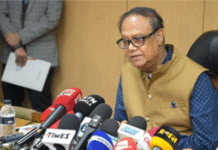Faruque Ahmed
The Finance Ministry finalized revenue expenditures as well as Annual Development Programmes (ADP) for both the revised budget of the current fiscal and the budget for next fiscal 2016-17. Next fiscal year’s budgetary expenditure target of the government has been set at Tk 340,000 crore, which was below one trillion only few years back. The national budget surging annually is creating a resources mobilization crisis and forcing the government to resort to excessive borrowing.
Big budget saturating resource crisis
The highest economic policy making body of the government, the Executive Committee of National Economic is yet to take the final decision on the overall size of the budget. Some disclosure, however, have been made.
Of the total outlay, Tk 229,736 crore to be earmarked as revenue expenditure proposed in next year’s budget. The revenue expenditure proposed has been estimated to be nearly 32 percent above the size of the revised budget. On the other hand, projected revenue earning for the next fiscal is up by nearly 36 percent.
But many fear, the projected revenue earning will fail to materialise, because of growing gap between revenue target and collection. A former Bangladesh Bank governor said that the 31.78 percent growth in revenue expenditure for the next fiscal 2016-17 would cause the government to resort to aggressive domestic borrowing, particularly from the banking sector and also by more sale of national saving certificates. The government’s declared salary hike for officers and employees and the government’s plans to recruit over 50,000 employees at different levels in the upcoming fiscal will require the government to allocate greater amounts for revenue expenditure. Though the finance ministry expressed optimism over achieving gigantic revenue earning targets next year and brushed off any possibility of enhanced borrowing beyond target estimate shown from domestic sources, economists are not optimistic.
The government has set Tk 242,752 crore revenue target for the next fiscal year, up by Tk 65,352 crore from this year. The government’s agencies and departments are keen to obtain huge funds for development expenditure in mega projects.
Economists fear that, the estimated GDP growth will stumble if revenue spending is greater than 20 percent of the total budget. Overall economic growth will then suffer.
They believe any plan that will violate fiscal discipline, a high spending budget that does not corroborate with fiscal reality and economic situation on the ground will boomerang at the end. Moreover, greater the budget is becoming, soaring corruprions and misuse of budgtary funds increasingly likned to spending on political activities is destroying the budgetary discipline and making the size of the budget and revenue gap ever greater.
In fact, government borrowing in the current budget for 2015-16 has exceeded the original estimates by a big margin. It is not only overloading debt servicing liability on future budgets, it is also leaving unattended the backlogs of excessive consumptions we made in the past for our next generation to bear.
Borrowing target already exceeded
Bangladesh Bank figure shows that the government borrowing has exceeded target in 8 months from July to February this year by a big margin.
Its liability from sales of different savings instruments totalled Tk 19,890.55 crore during this period exceeding the entire fiscal year’s target of Tk 18,000 crore. The Department of National Savings (DNS) sold bonds and savings certificates worth Tk 33,067.25 crore between July 2015 and February 2016 against the entire year’s target of Tk 36,500 crore.
Meanwhile, the government repaid Tk 13176.70 crore in principal amount and interest of Tk 7096.50 crore to the investors against the saving instruments. Economists like Dr Zaid Bakht believe that the high government borrowing from sales of saving certificates will only increase because of higher interest compared to interest paid on bank deposits. “A prolonged sluggish investment situation pushed many investors to invest in savings,” Dr. Bakht said.
Public investment led growth
The economic condition in Bangladesh is dull because private sector investors fear risk in political crisis. As a result, the country’s economic growth has already become dependent on the public sector investment. Recent reports showed private sector led GDP growth has declined while the GDP growth from public sector investment notably increased. This is going to be dangerous at some points, because it will not be possible for the government to sustain higher public spending from budgetary resources to keep the economy buoyant for long.
According to the revised budgetary outlay, the government is implementing a mega budget of Tk 287998 crore (original outlay was Tk. 295100 crore) in the current 2015-16 fiscal. Its expenditure plan is facing resource scarcity as revenue receipt was lower in the last seven months. The National Board of Revenue (NBR) collected Tk 79,968 crore in revenue during the July-January period against the total fiscal target of Tk 176,370 crore.
Apart from revenue, according to the budget plan, the government expects Tk 38,523 crore from banking system and Tk 38,039 crore from foreign assistance to finance the deficit in its budget outlay.
However, net foreign assistance totalled only $1.3 billion (Tk 10,400 crore approx) in the last seven months (July 2015-Janaury 2016) which is far short of the target, according to Bangladesh Bank data. The ADP implementation progress remains poor due to the resource constraints, that has forced the government to slash its development budget by Tk 7,102 crore from the original ADP outlay of Tk 100,996 crore to Tk 93,894 crore on April 26. Planning Minister A H M Mustafa Kamal told newsmen that Tk 64,734 crore would come from the national exchequer while the remaining Taka 29,160 crore would come as project assistance for the revised ADP allocation of Taka 93,894 crore. The ADP implementation from July to March however remained poor at 41 percent with an overall expenditure of Tk 41,888 crore. Planning Minister Mustafa Kamal himself blamed resource constraints as one of the reasons for it.
The government’s focus on construction of the Padma Bridge from its own budgetary resources is creating pressure on availability of resources for the budget. Non-development expenditure edged up also due to pay hike for public servants. In the budget for fiscal 2015-16, the revenue expenditure has been put at Tk 185,191 crore.
Policy outlines for external aid
As part of the government’s growing focus on harnessing more external assistances for development from new sources, the Economic Relations Division (ERD) of the ministry of finance is working on a draft of National Policy on Development Cooperation (NPDC). It aims at developing a consolidated framework for mobilising and managing the country’s development cooperation with external sources.
It has outlined the government priorities regarding the provision of foreign assistance. The policy includes preferred aid modalities, basic principles to be followed, the main procedures as well as corresponding roles and responsibilities for the provision, acceptance, coordination and management of foreign assistance.
The policy is expected to provide a vehicle for the government to demonstrate greater leadership in the overall development cooperation process and will also enable the government to derive greater benefit from overseas development assistance. The ERD has also unveiled a study on the country’s development finance assessment that dwelt on future trend of development financing. A daylong workshop on ‘Linking Finance and Results to Implement the Seventh Five Year Plan in the context of the SDGs’ discussed the strategy of future aid seeking and mobilization. SDGs are the United Nation’s new 15 year Sustainable Development Goals.
Asia Pacific Development Effectiveness Facility
Titled as ‘Development Finance Assessment (DFA): Bangladesh’. The initiative came at a time when the world had just adopted the UN Sustainable Development Goals and Bangladesh was formulating its 7th Five Year Plan.
If was the first assessment of its kind in Bangladesh covering all development finance flows including private and public as well as external and domestic resources while also providing a comprehensive mapping of past, current and future sources of development finance in Bangladesh.
The discussion in presence of State Minister for Finance and Planning, MA Mannan who is playing the key role in external resources mobilisation, found the DFA to be an opening for Bangladesh to reach new and old donors. “The DFA study can be harnessed for the pursuit of national development priorities as articulated in Bangladesh’s 7th Five Year Plan”, discussants said.
The DFA focussed on strengthening of national budget, domestic resource mobilisation, leveraging private sector, official development assistance (ODA), South-South Cooperation and International Climate Finance.
Asia Pacific Development Effectiveness Facility (AP-DEF), a regional platform on development effectiveness, of which Bangladesh is the chair, is closely working on adding new dimension to the country’s external resource mobilization platform.
It may work to establish better linkage with World Bank, Asian Development Bank, JICA and Japan government assistance, Chinese government assistance, Asian Infrastructure Investment Bank (AIIB) and other major European and Asian donors.
A number of countries in the Asia Pacific region including Philippines, Vietnam, Laos and Papua New Guinea successfully conducted similar studies which were quite helpful in improving their macroeconomic and development cooperation related policies.
The Bangladesh government leaders also believe that the DFA will provide inputs into the draft National Policy on Development Cooperation, and will also help to provide a deep understanding of the potential avenues of external and internal resources needed for its future development initiatives.
Source: weekly holiday









